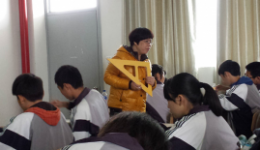初中英语陈述句,疑问句,祈使句及感叹句

A. 陈述句
初中英语对陈述句的考察主要集中在肯定陈述句和否定陈述句两种。
a. 陈述句的肯定式。
I have already posted the pictures.
They are teachers.
I must go now .
He was reading a magazine at 10:00 yesterday.
b.陈述句的否定式。
(1)谓语动词是系动词be, 助动词have, will, shall, be或情态动词,只须在其后面加not构成否定句。
She isn’t a teacher .
He hasn’t been to the zoo .
I can not sing .
(2)若谓语动词是实义动词,在实义动词前加上do not,第三人称单数现在时用does not,过去时用did not。
He didn’t send me an message .
(3)由具有否定含义的词never, nobody, hardly, little, few, seldom, too…to等构成的否定句.
Not all the books in our school library can be borrowed .

B. 疑问句
英语中有四种疑问句:一般疑问句、特殊疑问句、选择疑问句和反意疑问句。
a.一般疑问句:以一个助动词、情态动词、动词be或have开始,语调为升调,通常要求以yes或no回答的疑问句。
(1)一般疑问句的基本结构:
is, am, are, was, were+主语+表语
have, has, had+主语+宾语
can, may, must等+主语+行为动词或be…
do, does, did+主语+行为动词
shall, will, have, has+主语+行为动词
(2)否定形式的疑问句,通常把助动词与not缩写,放在句首。构成回答:
Aren’t you a teacher?
Yes, I am .(不,我是)
No, I am not .(对,我不是)
b. 特殊疑问句:以疑问代词who, what, whom, whose, which或疑问副词when, where, why, how开头的疑问句。
(1) 如果疑问词在句中作主语或其修饰主语时,其语序如陈述句。
Who is on duty today ?
Which book is me ?
(2) 如果疑问词在句中不作主语或其不修饰主语,用“疑问词+一般疑问句”形式。
Where have you been ?
c. 选择疑问句:提出两种或两种以上的情况,供回答者选择,并由or连用,但不能用Yes或no 来回答。
(1) 疑问句+选择成分1+or+选择成分2?
Do you want coffee or tea ?
Are you an Chinese or an American ?
(2) 特殊问句+选择答案1+or+选择答案2?
Who runs fast, Jerry , Tim or Lily ?
d. 反意疑问句:陈述部分+提问部分。
(1) 前肯后否,前否后肯
前后人称、数和时态要一致,疑问部分要用代词
如果前面陈述句中有否定词:hardly, little, few, never, nothing, none , nobody, not, no 等,后面疑问句应该用肯定式。
My grandma used to be a teacher, didn’t she ?
(2) 陈述句部分是复合句时,提问部分的主语和助动词要与主句一致。
He was reading when the teacher teacheray.com came in, wasn’t he ?
(3)在“I think(guess, suppose, believe)+宾语从句”中,当主语是第一人称时,附加疑问句的主语和谓语应与后面宾语从句相一致;但若主语不是第一人称时,则附加问句与前面主句一致。
I don’t think he can pass the exam, can he ?
He believed you had seen her before, didn’t he ?
(4)在含有情态动词must 的句子中,若must 表示推测,提问用must后面的动词。若must表示有必要时,用needn’t。若mustn’t表示禁止时,提问用must。
He must be surprised, isn’t he ?
You must go to Guangzhou, needn’t you?
You mustn’t parking here, must you ?
(5)陈述句部分为祈使句,疑问部分常用will you(表请求)。注:let’s 用shall we(包括说话人),let us 用will you(不包括说话人)。
Have a cup of tea, will you ?
Let’s go now, shall we ?
Let us go now, will you ?

C. 祈使句
可表示请求、命令、劝告、建议等。(省主语,动词用原形)
(1) let + 第一人称,第三人称+(not)动词原形。
Let me try another time .
(2) 动词原形+其他成分
Listen to me carefully .
(3) Don’t (never)+动词原形+其他成分。
Don’t look out of the window .
(4) Do+动词原形+其他成分。
Do give him another chance .
D. 感叹句
表示喜怒哀乐等强烈感情,句尾用“!”。What 修饰名词,how 修饰形容词、副词。
(1) How + 形容词 / 副词
How hot it is today !
How smart the girl is !
How slow she runs !
How hard the boys are working !
How smart a boy he is !
How funny an monkey it is !
(2)What + 名词
What a cold day it is today !
What an honest woman his mother is !
What small trees they are !
What good students the girls are !
What hot water it is !
What delicious dinner it is !
原创/安颖/北京市西城区英语教师,欢迎关注我的微信公众号teacheray,一起交流英语学习。
转载注明版权地址
http://www.teacheray.com






